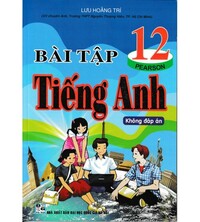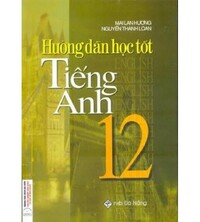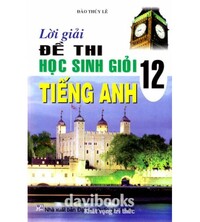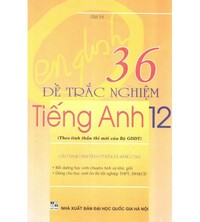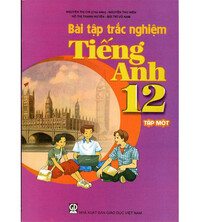Đề thi học kỳ 2 môn Tiếng Anh lớp 12 năm 2016 có đáp án
Trong bài viết này, mời các em học sinh cùng thử sức với Đề thi học kỳ 2 môn Tiếng Anh lớp 12 trường THPT Đa Phúc, Hà Nội năm học 2015 - 2016 mới nhất có kèm đáp án và các mã đề cụ thể. Sau đây mời các em cùng làm bài và tham khảo đáp án nhé!
Đề kiểm tra học kỳ 2 môn Tiếng Anh lớp 12 trường THPT Thanh Sơn, Phú Thọ năm học 2015 - 2016
Đề thi học kỳ 2 môn Tiếng Anh lớp 12 trường THPT Tân Uyên, Lai Châu năm học 2015 - 2016
Đề thi học kỳ 2 môn Tiếng Anh lớp 12 trường THPT Dương Háo Học, Trà Vinh năm học 2015 - 2016
|
TRƯỜNG THPT ĐA PHÚC ------------------ Mã đề: 12001 |
ĐỀ THI HỌC KỲ 2 NĂM HỌC 2015 - 2016 MÔN: TIẾNG ANH - LỚP 12 Thời gian làm bài: 45 phút |
I. Multiple choice
1. As all field players are only allowed to touch the ball with one hand at a time, they must develop the ability to catch and _______ the ball with either hand.
A. throw B. point C. score D. cross
2. People who exercise frequently have better physical endurance than those ___
A. who doesn't B. who don't C. that doesn't D. which don't
3. The cuisine of France is _______.
A. more famous than that of England B. famous than the cuisine of England
C. more famous than which of England D. as famous than that of England
4. Everyone ____ what they have to do, don't they?
A. know B. knows C. knew D. have known
5. Human beings have a great influence_______ our environment.
A. at B. about C. on D. in
6. Where can people play _______ water polo?
A. a B. an C. the D. x
7. Different people never read a book in ________ same way.
A. a B. an C. the D. x
8. Human beings are_____ for the changes in the environment.
A. account B. responsible C. blame D. faulty
9. His fatal disease made him to pursue that struggle for_________.
A. liveliness B. hope C. survival D. life
10. Tommy likes the books that he borrowed from the school library very much. He has read them with _____.
A. entertainment B. romance C. tasting D. pleasure
11. If the score is tied at the end of regulation play, two _______ periods of three minutes each are played.
A. half B. halftime C. quarter D. overtime
12. We missed the beginning of the play because it ______ when we arrived.
A. have started B. already started C. had already started D. had started already
13. Ellen _______ and sang her song.
A. nodded to the audience B. nodded the audience
C. was nodding the audience D. was nodded to the audience
14. The escaped prisoner is believed ______ on an island.
A. being lived B. to be living C. having lived D. that living
15. He was sacked because he had worked ______.
A. responsible B. irresponsible C. responsibly D. irresponsibly
16. Many young men prefer scuba-diving because it is _______.
A. adventure B. adventurous C. adventurously D. adventurist
17. The Red Cross organizes and leads relief assistance missions after ______, such as natural disasters, man-made disasters, and epidemics.
A. emergent B. emergencies C. emergently D. emergence
18. One of the tasks of the Red Cross is also to support local ________care projects.
A. health B. healthy C. healthful D. healthily
19. Sue: "I love pop music" Alice: "_______"
A. I do, too B. No, I won't C. Yes, I like it D. Neither do I
20. A: Do you believe that we are destroying our environment? B: _____________________
A. Yes, I believe in you. B. That's exactly what I think.
C. I believe in anything we do. D. It's certain that our environment is being destroyed.
21. The player of the visiting team scored the only goal in ______ first half.
A. the B. a C. an D. Ø
22. Women's contribution to our society has been ______ better these days.
A. differently B. naturally C. intellectually D. significantly
23. She sometimes ________to turn off the computer before she _____ home.
A. forgot / had gone B. has forgot / is going C. forgets / goes D. is forgetting / has gone
24. Many Asian people _______ like hunting elephants for their ivory and tigers for their bones.
A. particular B. particularity C. particularly D. particularize
25. My teacher wanted to know _______ the play called "Carmen".
A. if I saw B. whether I have seen C. if I had seen D. whether had I seen
II. Phonetics
26. Choose the word whose underlined part is pronounced differently from the others
A. casual B. case C. cashier D. cash
27. Choose the word whose underlined part is pronounced differently from the others
A. success B. enthusiast C. support D. surprise
28. Choose the word which is stressed differently from the rest.
A. employment B. remember C. concentrate D. position
29. Choose the word whose underlined part is pronounced differently from the others
A. average B. indicate C. application D. grade
30. Choose the word which is stressed differently from the rest.
A. receive B. proper C. process D. factor
III. Reading: Fill in each numbered blank with one suitable word.
Under the global "health for all" strategy, WHO (the World Health Organization) and its members have placed special emphasis (31) _____ the developing countries. Nevertheless, the benefits of WHO's international health work are benefited by all countries, including the most developed ones. For example, all nations have benefited from their contributions to the WHO programs that led to the global (32) _____ of smallpox and to better and cheaper ways of controlling tuberculosis.
(33) _____ is a key word in WHO's programs. The organization believes that immunization, (34) _____ prevents the six major diseases of childhood-diphtheria, measles, poliomyelitis, tetanus, tuberculosis, and whooping cough-should be (35) _____ to all children who need it.
31. A. on B. in C. for D. with
32. A campaign B. spread C. eradication D. epidemic
33. A. Prevent B. Prevention C. Preventable D. Prevented
34. A. whom B. whose C. that D. which
35. A. prepared B. concerned C. interested D. available
VI. Reading comprehension
There is very little documentation about the origins of water polo. It is known, however, that the sport originated in the rivers and lakes of mid-19th century England as an aquatic version of rugby. Early games used an inflated rubber ball that came from India known as a "pulu" (the single Indian word for all "balls"). Pronounced "polo" by the English, both the game and the ball became known as "water polo." To attract more spectators to swimming exhibitions, the London Swimming Association designed a set of water polo rules for indoor swimming pools in 1870. At first, players scored by planting the ball on the end of the pool with both hands. A favorite trick of the players was to place the five-to-nine inch rubber ball inside their swimming suit and dive under the murky water, they would then appear again as close to the goal as possible. The introduction of the rules by Scottish players changed the nature of water polo. It became a game that emphasized swimming, speed and passing. Scottish rules moved from a rugby variant to a soccer style of play. Goals became a cage of 10x 3 feet and a goal could be scored by being thrown. Players could only be tackled when they "held" the ball and the ball could no longer be taken under water. The small rubber ball was replaced by a leather soccer ball. If the player came up too near the goal, he was promptly jumped on by the goalie, who was permitted to stand on the pool deck. Games were often nothing more than gang fights in the water as players ignored the ball, preferring underwater wrestling matches that usually ended with one man floating to the surface unconscious. Water polo was first played in the USA in 1888. The game featured the old rugby style of play which resembled American football in the water. "American style" water polo became very popular and by the late 1890s was played in such venues as Madison Square Garden and Boston's Mechanics Hall, attracting 14,000 spectators to national championship games.
36. According to the text, _______.
A. the origins of water polo are written thoroughly in a lot of documents
B. water polo is an aquatic version of rugby
C. water polo first appeared somewhere outside England
D. people have played water polo since the early 19th century.
37. The present rules of water polo were invented _______.
A. by Scottish players B. by Indian players
C. the London Swimming Association D. in 1870
38. In water polo, the players score a goal by _______.
A. swimming B. passing C. catching D. throwing
39. The present water polo ball is made of _______.
A. rubber B. leather C. bone D. wood
40. Water polo became popular in America in _______.
A. the middle of the 19th century B. in 1870
C. in 1888 D. by the late 1890s

